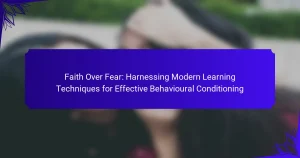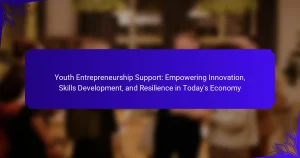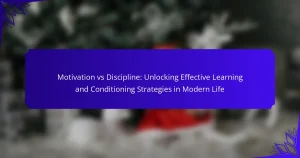Rethinking learning and conditioning strategies is essential for achieving better outcomes. This article explores the need for innovative techniques, the role of adaptability and engagement, and the importance of personalized learning experiences. It highlights common mistakes that hinder progress and emphasizes the use of technology and diverse approaches to enhance retention and performance. Regular evaluation of methods will lead to improved effectiveness and more meaningful educational practices.
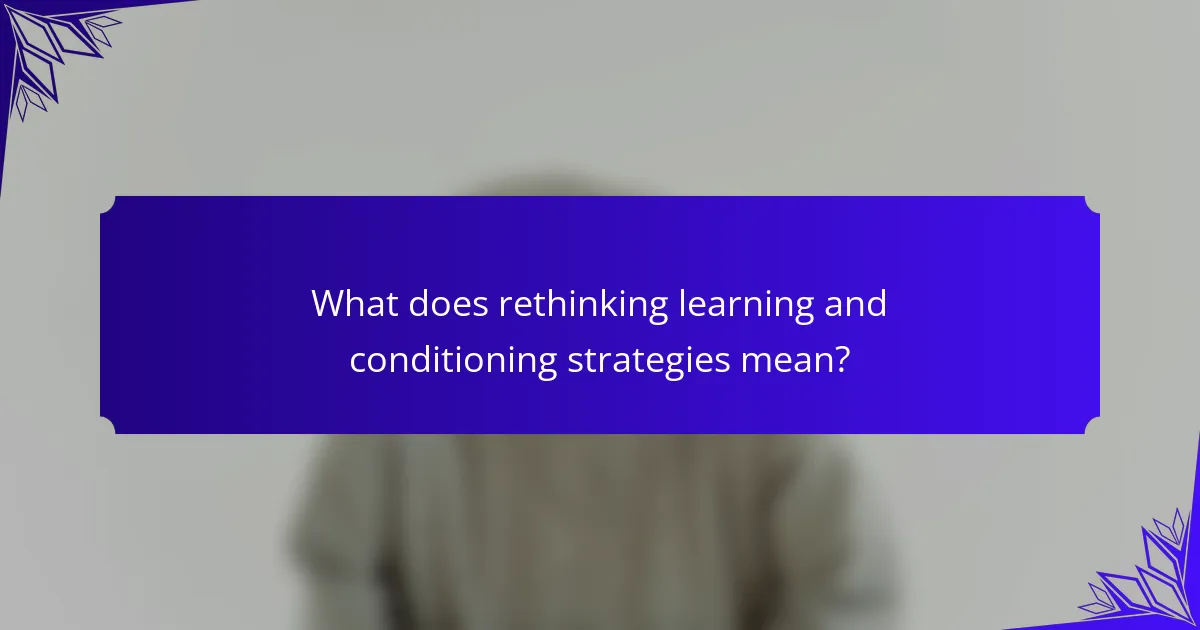
What does rethinking learning and conditioning strategies mean?
Rethinking learning and conditioning strategies means evaluating and modifying approaches to achieve better outcomes. Traditional methods often yield stagnant results, prompting the need for innovative techniques. By incorporating diverse learning modalities and adaptive conditioning, individuals can enhance retention and performance. This shift emphasizes the importance of personalization in learning experiences, leading to more effective and engaging educational practices.
How does traditional learning often lead to stagnation?
Traditional learning often leads to stagnation because it relies on repetitive methods that fail to adapt to individual needs. This approach limits critical thinking and creativity, resulting in minimal engagement. As learners encounter the same content and strategies, they may become disengaged and unmotivated. Research shows that varied learning experiences enhance retention and application, highlighting the need for innovative teaching methods. Adapting strategies to include diverse formats can foster deeper understanding and prevent stagnation.
What are the psychological foundations behind the phrase?
The psychological foundations behind the phrase highlight the cognitive bias known as insanity, which is often attributed to Albert Einstein. This concept suggests that repeating the same behavior while expecting different outcomes reflects a lack of awareness or understanding of the learning and conditioning processes. Individuals may cling to familiar methods despite their ineffectiveness, driven by comfort or fear of change. This behavior underscores the necessity for adaptive learning strategies that encourage critical thinking and experimentation, fostering more effective problem-solving approaches.
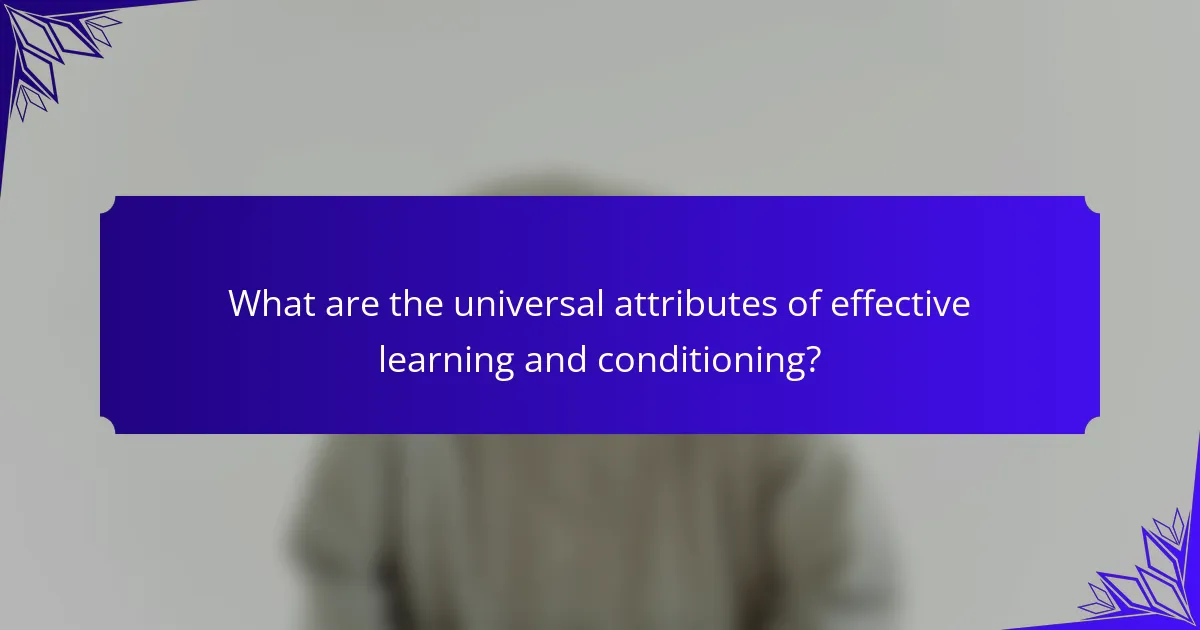
What are the universal attributes of effective learning and conditioning?
Effective learning and conditioning rely on adaptability, reinforcement, engagement, and feedback. These universal attributes ensure that strategies evolve to meet changing needs and contexts. Adaptability allows learners to adjust approaches based on outcomes. Reinforcement strengthens desired behaviors through consistent rewards. Engagement fosters active participation, enhancing retention. Feedback provides essential insights for improvement, guiding future efforts.
What role does feedback play in learning processes?
Feedback is crucial in learning processes as it informs individuals about their performance and guides improvement. It helps identify strengths and weaknesses, fostering a growth mindset. Effective feedback enhances motivation and engagement, leading to better retention of information. Continuous feedback loops allow learners to adjust strategies, ensuring they do not repeat ineffective methods. This approach aligns with the principle of rethinking learning and conditioning strategies for improved outcomes.
How do motivation and reinforcement influence behavior?
Motivation and reinforcement significantly shape behavior by influencing decision-making processes. Motivation drives individuals to pursue goals, while reinforcement strengthens desired behaviors through rewards or consequences. Together, they create a feedback loop that enhances learning and conditioning strategies. For example, positive reinforcement can increase the likelihood of repeating a behavior, whereas negative reinforcement can lead to avoidance of undesirable actions. Understanding these dynamics can lead to more effective learning strategies and behavior modification techniques.
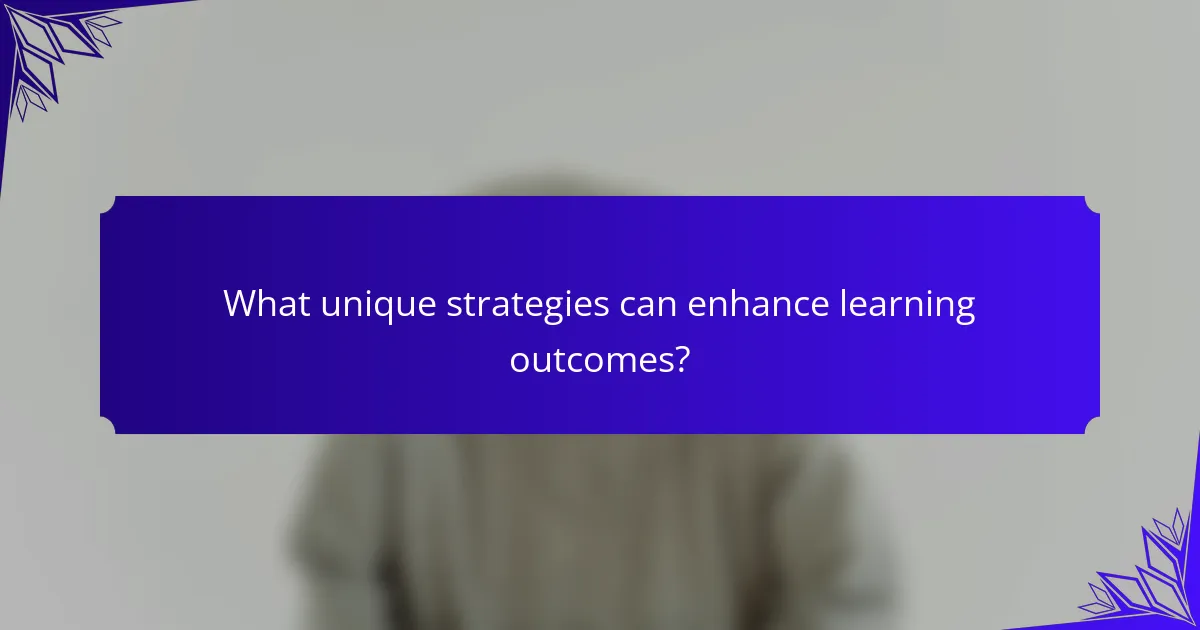
What unique strategies can enhance learning outcomes?
To enhance learning outcomes, unique strategies must be employed that deviate from traditional methods. Incorporating active learning techniques, such as problem-based learning and collaborative projects, fosters deeper engagement. Utilizing technology, like adaptive learning platforms, tailors education to individual needs, improving retention. Implementing regular feedback loops encourages reflection and adjustment, reinforcing concepts. Emphasizing real-world applications connects learning to practical scenarios, enhancing relevance and motivation.
How can personalized learning approaches transform conditioning?
Personalized learning approaches can significantly enhance conditioning by tailoring strategies to individual needs. This method fosters engagement and retention, leading to more effective outcomes. Personalized techniques, such as adaptive learning technologies, allow for real-time adjustments based on performance data. As a result, learners receive targeted feedback, which accelerates their mastery of concepts. This transformation shifts the focus from a one-size-fits-all model to a more dynamic and responsive learning environment.
What is the impact of technology on modern learning strategies?
Technology significantly enhances modern learning strategies by enabling personalized, interactive, and accessible education. It allows for adaptive learning platforms that cater to individual needs, fostering engagement and retention. For example, data analytics can track student progress and tailor content accordingly, leading to improved outcomes. Additionally, technology facilitates collaborative learning through online platforms, connecting learners globally. As a result, the integration of technology redefines traditional educational approaches, making learning more effective and inclusive.
How do online platforms facilitate adaptive learning?
Online platforms enhance adaptive learning by personalizing educational experiences to individual needs. They utilize data analytics to track learner progress and adapt content accordingly. This tailored approach improves engagement and retention, addressing the unique learning pace and style of each user. Additionally, features like real-time feedback and interactive assessments foster a dynamic learning environment that evolves with the learner.
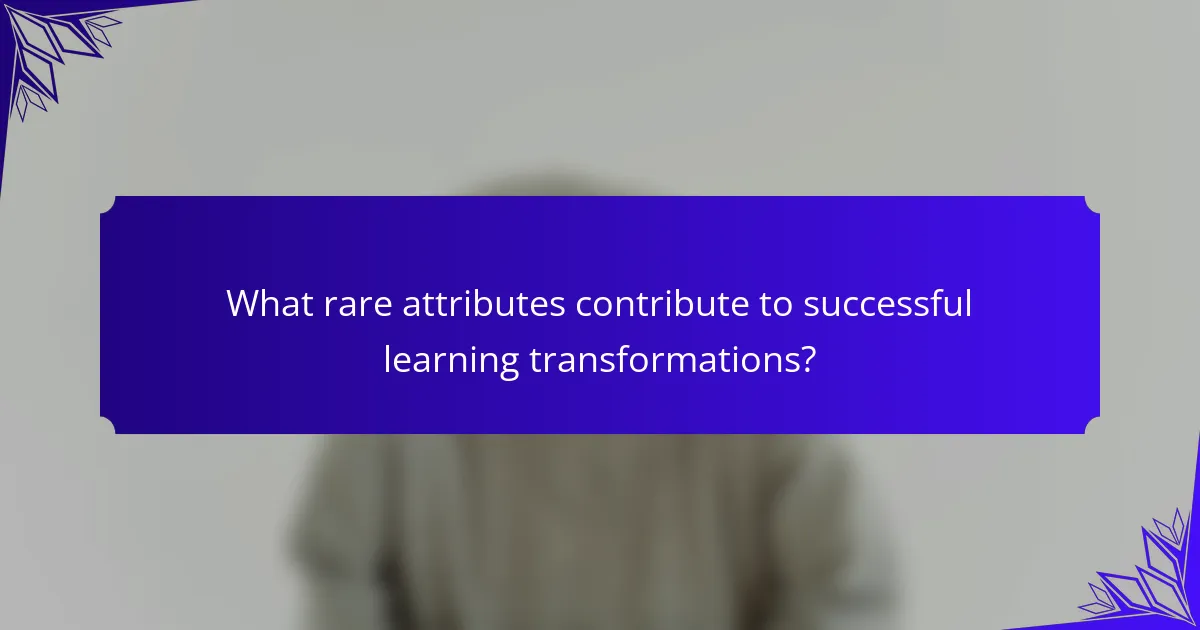
What rare attributes contribute to successful learning transformations?
Innovative approaches and adaptability are rare attributes that significantly contribute to successful learning transformations. These attributes enable learners to embrace change and explore new strategies. Adopting a growth mindset enhances resilience, allowing individuals to navigate challenges effectively. Moreover, personalized learning experiences cater to unique needs, fostering deeper engagement and retention. Finally, leveraging technology can facilitate access to diverse resources, promoting a more dynamic learning environment.
What is the significance of emotional intelligence in learning?
Emotional intelligence significantly enhances learning by fostering self-awareness, empathy, and interpersonal skills. These attributes facilitate better communication and collaboration among learners. As a result, individuals with high emotional intelligence adapt more readily to new learning environments and experiences. They also demonstrate improved resilience, which is crucial for overcoming challenges in the learning process. Ultimately, emotional intelligence transforms traditional conditioning strategies by integrating emotional awareness into educational practices.
How can cultural context shape learning strategies?
Cultural context significantly influences learning strategies by shaping how individuals perceive and engage with information. Different cultures prioritize various skills, values, and communication styles, which directly affect learning preferences and effectiveness.
For example, collectivist cultures may emphasize collaborative learning, while individualistic cultures might favor independent study. Understanding these differences allows educators to tailor their approaches, ensuring that learning strategies resonate with diverse cultural backgrounds.
Moreover, cultural norms can dictate the acceptable methods of feedback and assessment, impacting motivation and self-efficacy. Adapting learning strategies to align with cultural contexts enhances the overall educational experience, leading to better outcomes for learners.
In summary, recognizing and integrating cultural context into learning strategies fosters inclusivity and maximizes engagement, ultimately resulting in more effective educational practices.
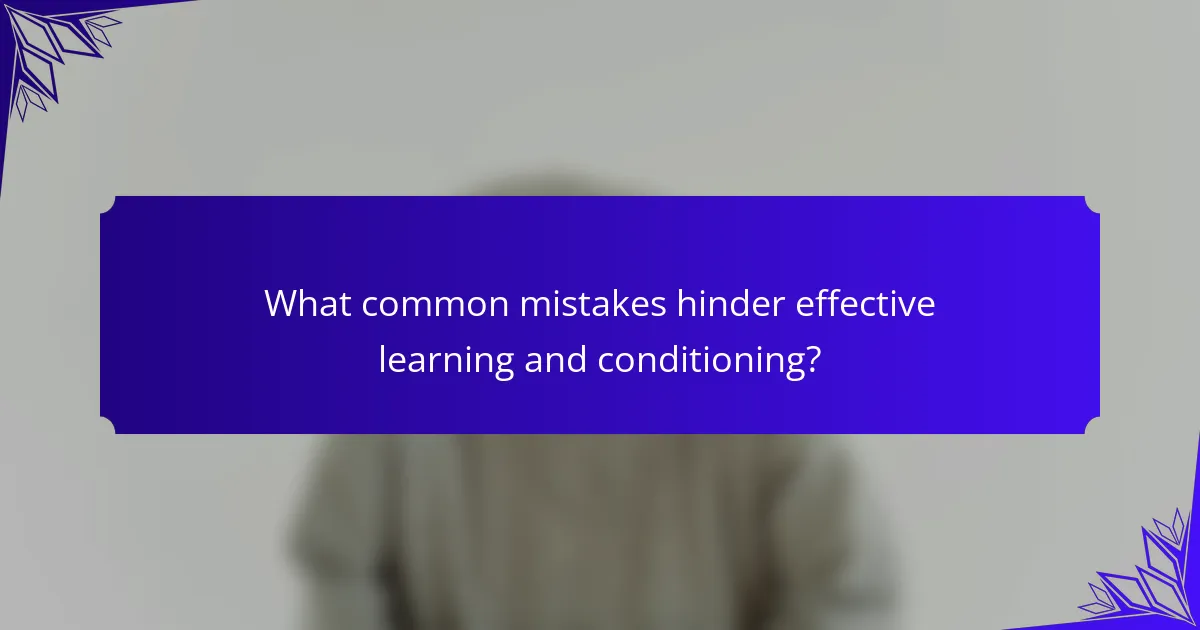
What common mistakes hinder effective learning and conditioning?
Common mistakes that hinder effective learning and conditioning include failing to adapt strategies and not tracking progress. Sticking to the same methods while expecting different outcomes leads to stagnation. Regularly assessing and modifying approaches is essential for improvement. Additionally, neglecting to understand individual learning styles can limit effectiveness. Engaging with diverse techniques enhances retention and application of knowledge.
How does resistance to change affect learning efforts?
Resistance to change significantly hinders learning efforts by maintaining outdated practices. This inertia prevents the adoption of innovative strategies essential for effective learning and conditioning. As a result, organizations may experience stagnation in skill development and knowledge retention. Overcoming this resistance requires fostering a culture that embraces adaptability and continuous improvement.
What are the pitfalls of a one-size-fits-all approach?
A one-size-fits-all approach often leads to ineffective learning outcomes. It disregards individual differences in learning styles, needs, and paces, resulting in disengagement. Customization enhances motivation and retention, addressing unique attributes of learners. This approach can also overlook contextual factors that influence learning, such as environment and prior knowledge. Ultimately, failing to adapt strategies can perpetuate the same ineffective results, hindering progress and growth.
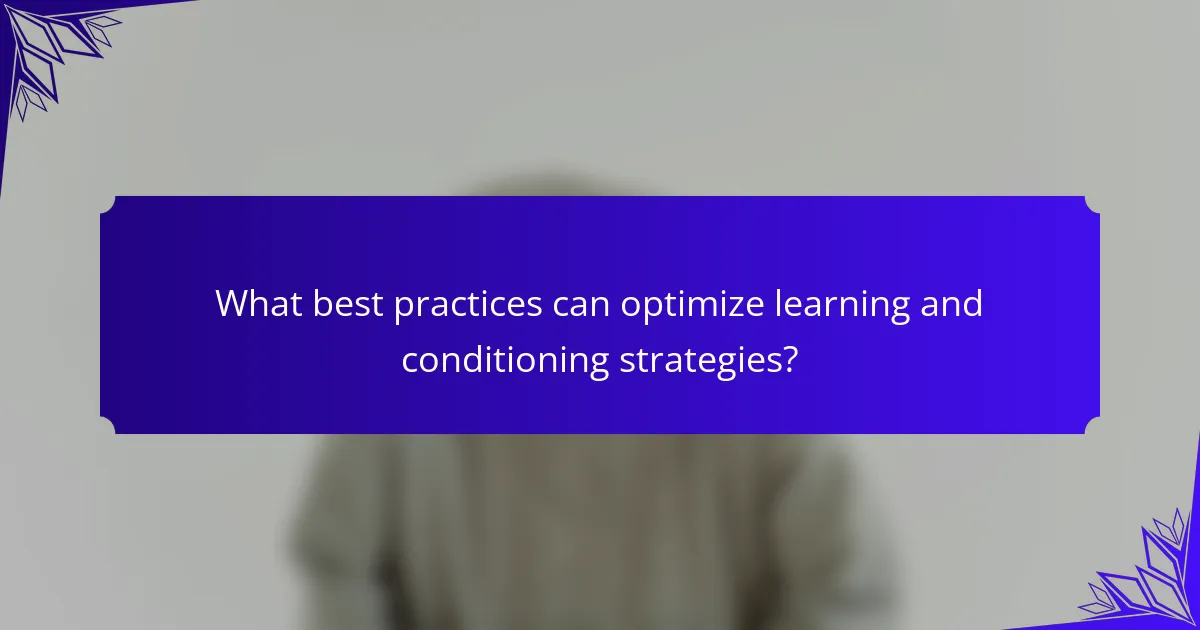
What best practices can optimize learning and conditioning strategies?
To optimize learning and conditioning strategies, implement varied approaches and adapt techniques based on feedback. Consistent evaluation of methods enhances effectiveness and promotes better outcomes. Incorporate diverse learning styles, utilize technology, and encourage active participation. Regularly assess progress to refine strategies and achieve desired results.
How can continuous assessment improve learning outcomes?
Continuous assessment enhances learning outcomes by providing ongoing feedback, allowing students to identify strengths and weaknesses. This approach fosters a growth mindset, encouraging adaptation and improvement. Research indicates that formative assessments can increase student engagement and retention by 20%. Additionally, tailored feedback helps in personalizing learning experiences, addressing individual needs effectively. By shifting focus from high-stakes testing to regular evaluations, educators can create a more supportive and responsive learning environment.
What techniques promote adaptability in learning environments?
Adaptability in learning environments can be promoted through various techniques such as differentiated instruction, collaborative learning, and formative assessments. These strategies encourage flexibility and responsiveness to individual learner needs.
Differentiated instruction tailors teaching methods to accommodate diverse learning styles and paces. Collaborative learning fosters peer interaction, enhancing problem-solving skills and adaptability. Formative assessments provide ongoing feedback, allowing adjustments to teaching strategies based on student performance.
Incorporating technology can further enhance adaptability. Tools like learning management systems and interactive platforms facilitate personalized learning experiences, making it easier for educators to modify approaches as needed.
Ultimately, these techniques create a dynamic learning environment, fostering resilience and adaptability in students.
How can collaboration enhance learning experiences?
Collaboration enhances learning experiences by fostering diverse perspectives, improving problem-solving skills, and increasing engagement. It allows learners to share knowledge, which can lead to deeper understanding and retention of information. Collaborative environments encourage active participation, promoting accountability among peers. As a result, learners are more likely to develop critical thinking and interpersonal skills essential for future success.
What actionable steps can individuals take to rethink their learning strategies?
To rethink learning strategies, individuals should adopt diverse methods to enhance their understanding. First, assess current approaches and identify ineffective patterns. Second, incorporate active learning techniques such as summarizing information or teaching others. Third, set specific, measurable goals to track progress. Fourth, seek feedback regularly to refine strategies. Finally, embrace a growth mindset to remain open to change and improvement.
